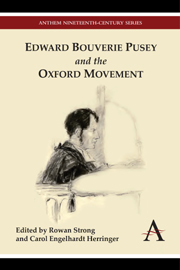Book contents
- Frontmatter
- Contents
- Acknowledgements
- Notes on Contributors
- Chapter One Introduction
- Chapter Two The History of the History of Pusey
- Chapter Three Editing Liddon: From Biography to Hagiography?
- Chapter Four From Modern-Orthodox Protestantism to Anglo-Catholicism: An Enquiry into the Probable Causes of the Revolution of Pusey's Theology
- Chapter Five Defining the Church: Pusey's Ecclesiology and its Eighteenth-Century Antecedents
- Chapter Six Pusey's Eucharistic Doctrine
- Chapter Seven Pusey, Alexander Forbes and the First Vatican Council
- Chapter Eight Pusey and the Scottish Episcopal Church: Tractarian Diversity and Divergence
- Bibliography
- Index
Chapter Six - Pusey's Eucharistic Doctrine
Published online by Cambridge University Press: 05 April 2013
- Frontmatter
- Contents
- Acknowledgements
- Notes on Contributors
- Chapter One Introduction
- Chapter Two The History of the History of Pusey
- Chapter Three Editing Liddon: From Biography to Hagiography?
- Chapter Four From Modern-Orthodox Protestantism to Anglo-Catholicism: An Enquiry into the Probable Causes of the Revolution of Pusey's Theology
- Chapter Five Defining the Church: Pusey's Ecclesiology and its Eighteenth-Century Antecedents
- Chapter Six Pusey's Eucharistic Doctrine
- Chapter Seven Pusey, Alexander Forbes and the First Vatican Council
- Chapter Eight Pusey and the Scottish Episcopal Church: Tractarian Diversity and Divergence
- Bibliography
- Index
Summary
Introduction
The Victorian Church of England was riven by a heated conflict over the meaning and nature of the Eucharist. Traditionally Anglicans could believe either that the consecrated bread and wine were used as, but not changed into, Christ's body and blood – which was known as the virtualist view – or that Christ was present only to the worthy communicant, which was the receptionist view. The rather peaceful coexistence of these two views was challenged beginning in the late 1830s, when the Tractarian doctrine of the Real Presence introduced theological and liturgical strife into the established church. This doctrine held that Christ was ‘really’ present in, or in conjunction with, the consecrated bread and wine. The doctrine quickly found adherents in the Scottish Episcopal Church as well; and by the 1860s ritualists had introduced liturgical practices associated with it – including bowing to the altar, kneeling during communion and even reserving the sacrament – at the parish level.
This new doctrine was denounced by traditional Anglicans who were horrified by what seemed to them to be crypto–Roman Catholicism. While the preferred form of dispute was through the spoken and written word, some of the more excitable opponents of the doctrine disrupted church services, and clergymen who preached the doctrine were prosecuted in church and civil courts. The controversies were so fierce and so prolonged partly because, while they were about liturgy and doctrine, they were also about deeper issues of whether the Church of England was Catholic or Protestant and whether material objects could have a central role in Christian worship.
- Type
- Chapter
- Information
- Edward Bouverie Pusey and the Oxford Movement , pp. 91 - 114Publisher: Anthem PressPrint publication year: 2012



